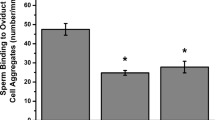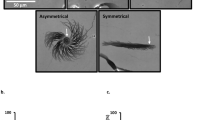Abstract
‘CAPACITATION’ was defined by Chang1 as the final maturation of spermatozoa in the female genital tract. Since Chang's report considerable research has been directed towards this phenomenon2,3. Capacitation has been observed outside the female tract in such areas as the eye or urinary bladder4 as well as in vitro with follicular fluid5 or eosinophils6. The viability of ejaculated sperm is determined by factors such as levels of oestrogen and progesterone7, and the phase of the oestrous cycle, including the different positions in the female genital tract8. Hunter9 has recently demonstrated in hamsters that ejaculated spermatozoa exposed to oestrous uterus underwent capacitation with a high rate of zona penetration. He concluded that an incubation effect occurred directly between the uterine environment and the spermatozoa. Even though the epididymal sperm were capacitated, they were not very fertile9. It seems that for normal fertilization the uterine environment and seminal plasma are indispensable factors. In studying mammalian fertilization I became interested in the role of the uterine epithelium in capacitation. This preliminary report describes uterine changes during capacitation. A detailed report will be published elsewhere.
This is a preview of subscription content, access via your institution
Access options
Subscribe to this journal
Receive 51 print issues and online access
$199.00 per year
only $3.90 per issue
Buy this article
- Purchase on Springer Link
- Instant access to full article PDF
Prices may be subject to local taxes which are calculated during checkout
Similar content being viewed by others
References
Chang, M. C., Nature, 168, 697 (1951).
Austin, C. R., The Mammalian Egg (Thomas, Springfield, 1961).
Symp. on Capacitation of Spermatozoa and Endocrine Control of Spermatogenesis (edit. by Duncan, D. W., Ericsson, R. J., and Zimbalman, R. G.), J. Reprod. Fert., Suppl. 2 (1967).
Noyes, R. W., and Thiabault, C., Fert. Ster., 13, 346 (1962).
Yanagimachi, R., J. Repr. Fert., 18, 275 (1969).
Ericsson, R. J., Nature, 221, 568 (1969).
Burrows, H., Biological Actions of Sex Hormones (Cambridge Univ. Press, 1945).
Restall, B. J., Adv. Reprod. Physiol. (edit. by McLaren, A.), 181 (Academic Press, New York, 1967).
Hunter, R. H. F., J. Reprod. Fert., 20, 223 (1969).
Gomori, G., Microscopic Histochemistry (Chicago Univ. Press, 1952).
Pearce, A. G. E., Histochemistry, 1 (Churchill, London, 1968).
Mann, T., Nature, 224, 649 (1969).
Gibbons, R. A., Biochem. J., 72, 27P (1959).
Mounib, M. S., and Chang, M. C., Nature, 201, 943 (1964).
Author information
Authors and Affiliations
Rights and permissions
About this article
Cite this article
LAKSHMAN, A. Uterine Changes during Capacitation in the Golden Hamster. Nature 229, 49–50 (1971). https://doi.org/10.1038/229049a0
Received:
Issue Date:
DOI: https://doi.org/10.1038/229049a0
Comments
By submitting a comment you agree to abide by our Terms and Community Guidelines. If you find something abusive or that does not comply with our terms or guidelines please flag it as inappropriate.



